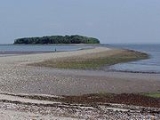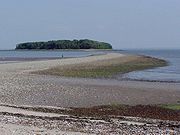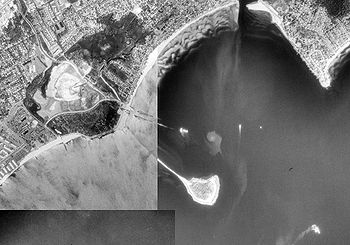
Charles Island
Encyclopedia
Charles Island is a 14 acre (57,000 m²) island
located roughly 0.5 mile (1 km) off the coast of Milford, Connecticut
, in Long Island Sound
centered at 41°11′28.32"N 73°03′18"W.
Charles Island is accessible from shore via a tombolo
(locally referred to as a sandbar), which is exposed at low tide. According to early local histories, the Sachem Ansantawae resided there during the summer months. European discovery of the island occurred in 1614 when Adriaen Block
sailed through and mapped Long Island Sound
. The island appears on his hand-drawn map found in The Netherlands National Archives.
After the Milford area was settled by the English in 1639 the island was referred to as Milford Island. After Charles Deal bought the island in 1657 it became known as Charles Island. Deal made a failed attempt to raise tobacco on the island – one of the first such efforts in Connecticut.
Local records indicate that Captain William Kidd
visited Milford in 1699 when he was en route to Boston (where he was subsequently arrested for piracy and murder). Before Kidd’s arrival in Boston, he off-loaded and buried treasure on Gardiners Island
off the eastern tip of Long Island
. The treasure was retrieved after his arrest but questions remain as to whether all the treasure was in that cache and whether he may have buried more of it along Long Island Sound. Since it is known he visited Milford on his last voyage, it has been speculated that he may have buried some of his treasure on the mainland or on Charles Island.
 In 1835, the first permanent residence was constructed on the island by John Harris. After his death the island was owned by several different owners and in 1852 it was purchased by Elizur Pritchard of Waterbury, Connecticut
In 1835, the first permanent residence was constructed on the island by John Harris. After his death the island was owned by several different owners and in 1852 it was purchased by Elizur Pritchard of Waterbury, Connecticut
who turned the large house into a summer resort known originally as Charles Island House and later as Ansantawae House. After the Civil War the resort closed and the island was leased to the George Miles Company as a base for their fish fertilizer operations. After the Miles Company left the island it was relatively unused until the 1930s when the Dominican Order
opened a religious retreat on the island. The Aquinas Retreat consisted of a chapel, small cabins for the retreatants, a central dining hall and religious shrines located along paths throughout the island. The retreat closed in the late 1930s and some remnants of it remain on the island.
The State of Connecticut now owns the island and it is part of Silver Sands State Park
. It is designated a Natural Area Preserve for the local bird population of heron
s and egrets. White-tail deer are common as well. The waters around the island have bluefish
, snapper blues, sand shark
s, and horseshoe crab
s.
Though an island during high tide
, during low tide it is accessible by foot using a rocky tombolo
that stretches from the beach to the island. Visitors are cautioned about the strong undertow and twice-daily flooding of the sandbar as a result of the tides. Currently (2005) the crossing window is at least two hours. However, Milford locals note that earlier in the 20th century the window was much greater, but erosion
has reduced the size and width of the island and sandbar.
Kayakers paddling on the side of the island not facing the Connecticut shore can be surprised by the wind and rougher waves, according to a spokesman for the Milford Fire Department. At about 2 a.m. on September 6, 2009, a 22-year-old kayaker went missing after his boat capsized. Another man with him swam to safety, but after more than a month, the victim's body had not been found.
 The island was allegedly cursed three times. The first curse was brought in the late 17th century by an Indian chief, whose tribe fought for the island which they felt was sacred—and "spirited"--ground. After the settlers defeated the Indians, the chief proclaimed, "Any shelter will crumble to the Earth, and he shall be cursed." Some feel this is the reason why no building has ever lasted on the island for more than a short period of time. The second curse was supposedly brought by Captain Kidd in 1699 when he allegedly buried some of his treasure there. Captain Kidd cursed anyone who attempted to dig up his treasure with certain death. The third curse was supposedly brought in 1721 by five sailors who stole Mexican emperor Guatmozin's treasure from a cave and brought it back to Connecticut. Guatmozin proclaimed a curse on the stolen treasure. After four of the five sailors suffered a death, the last sailor hid the treasure in the basement of the old Milford Inn. After it was accidentally discovered by a drunken customer searching the cellar for beer, the fifth sailor supposedly transported it to Charles Island in the dead of night, bringing the third curse along with him.
The island was allegedly cursed three times. The first curse was brought in the late 17th century by an Indian chief, whose tribe fought for the island which they felt was sacred—and "spirited"--ground. After the settlers defeated the Indians, the chief proclaimed, "Any shelter will crumble to the Earth, and he shall be cursed." Some feel this is the reason why no building has ever lasted on the island for more than a short period of time. The second curse was supposedly brought by Captain Kidd in 1699 when he allegedly buried some of his treasure there. Captain Kidd cursed anyone who attempted to dig up his treasure with certain death. The third curse was supposedly brought in 1721 by five sailors who stole Mexican emperor Guatmozin's treasure from a cave and brought it back to Connecticut. Guatmozin proclaimed a curse on the stolen treasure. After four of the five sailors suffered a death, the last sailor hid the treasure in the basement of the old Milford Inn. After it was accidentally discovered by a drunken customer searching the cellar for beer, the fifth sailor supposedly transported it to Charles Island in the dead of night, bringing the third curse along with him.
No one has ever found any of the treasures buried on the island, but local legend says that two treasure hunters came very close in 1850. They found an iron chest that was buried at the island. As they attempted to open it, a "screeching, flaming skeleton descended from the sky". It lurched into the pit where the treasure lay, sending forth a shower of blue flames. The treasure hunters were so terrified that they dropped their tools and fled the island. The following day, the two returned to the island only to find that their tools were gone and the digging site had been smoothly covered up, as if they had never even been there. Some say that the two men spent the rest of their lives in an insane asylum while others say that they were beheaded by the spirits of the Paugussett Indians, who made the treasure invisible.
Many people who have visited the island in recent years have reported seeing glowing ghosts in trees and hearing the sounds of disembodied voices and music of festivities from the past. Some think that the ghosts may even be phantom monks, who continue to make their processionals through the monastery ruins.
Island
An island or isle is any piece of sub-continental land that is surrounded by water. Very small islands such as emergent land features on atolls can be called islets, cays or keys. An island in a river or lake may be called an eyot , or holm...
located roughly 0.5 mile (1 km) off the coast of Milford, Connecticut
Milford, Connecticut
Milford is a coastal city in southwestern New Haven County, Connecticut, United States, located between Bridgeport and New Haven. The population was 52,759 at the 2010 census...
, in Long Island Sound
Long Island Sound
Long Island Sound is an estuary of the Atlantic Ocean, located in the United States between Connecticut to the north and Long Island, New York to the south. The mouth of the Connecticut River at Old Saybrook, Connecticut, empties into the sound. On its western end the sound is bounded by the Bronx...
centered at 41°11′28.32"N 73°03′18"W.
Charles Island is accessible from shore via a tombolo
Tombolo
A tombolo, from the Italian tombolo, derived from the Latin tumulus, meaning 'mound,' and sometimes translated as ayre , is a deposition landform in which an island is attached to the mainland by a narrow piece of land such as a spit or bar. Once attached, the island is then known as a tied island...
(locally referred to as a sandbar), which is exposed at low tide. According to early local histories, the Sachem Ansantawae resided there during the summer months. European discovery of the island occurred in 1614 when Adriaen Block
Adriaen Block
Adriaen Block was a Dutch private trader and navigator who is best known for exploring the coastal and river valley areas between present-day New Jersey and Massachusetts during four voyages from 1611 to 1614, following the 1609 expedition by Henry Hudson...
sailed through and mapped Long Island Sound
Long Island Sound
Long Island Sound is an estuary of the Atlantic Ocean, located in the United States between Connecticut to the north and Long Island, New York to the south. The mouth of the Connecticut River at Old Saybrook, Connecticut, empties into the sound. On its western end the sound is bounded by the Bronx...
. The island appears on his hand-drawn map found in The Netherlands National Archives.
After the Milford area was settled by the English in 1639 the island was referred to as Milford Island. After Charles Deal bought the island in 1657 it became known as Charles Island. Deal made a failed attempt to raise tobacco on the island – one of the first such efforts in Connecticut.
Local records indicate that Captain William Kidd
William Kidd
William "Captain" Kidd was a Scottish sailor remembered for his trial and execution for piracy after returning from a voyage to the Indian Ocean. Some modern historians deem his piratical reputation unjust, as there is evidence that Kidd acted only as a privateer...
visited Milford in 1699 when he was en route to Boston (where he was subsequently arrested for piracy and murder). Before Kidd’s arrival in Boston, he off-loaded and buried treasure on Gardiners Island
Gardiners Island
Gardiners Island is a small island in the town of East Hampton, New York, in eastern Suffolk County; it is located in Gardiners Bay between the two peninsulas at the eastern end of Long Island. It is long, wide and has of coastline...
off the eastern tip of Long Island
Long Island
Long Island is an island located in the southeast part of the U.S. state of New York, just east of Manhattan. Stretching northeast into the Atlantic Ocean, Long Island contains four counties, two of which are boroughs of New York City , and two of which are mainly suburban...
. The treasure was retrieved after his arrest but questions remain as to whether all the treasure was in that cache and whether he may have buried more of it along Long Island Sound. Since it is known he visited Milford on his last voyage, it has been speculated that he may have buried some of his treasure on the mainland or on Charles Island.

Waterbury, Connecticut
Waterbury is a city in New Haven County, Connecticut, on the Naugatuck River, 33 miles southwest of Hartford and 77 miles northeast of New York City...
who turned the large house into a summer resort known originally as Charles Island House and later as Ansantawae House. After the Civil War the resort closed and the island was leased to the George Miles Company as a base for their fish fertilizer operations. After the Miles Company left the island it was relatively unused until the 1930s when the Dominican Order
Dominican Order
The Order of Preachers , after the 15th century more commonly known as the Dominican Order or Dominicans, is a Catholic religious order founded by Saint Dominic and approved by Pope Honorius III on 22 December 1216 in France...
opened a religious retreat on the island. The Aquinas Retreat consisted of a chapel, small cabins for the retreatants, a central dining hall and religious shrines located along paths throughout the island. The retreat closed in the late 1930s and some remnants of it remain on the island.
The State of Connecticut now owns the island and it is part of Silver Sands State Park
Silver Sands State Park
Silver Sands State Park is a Connecticut State park in Milford, Connecticut, USA which offers facilities for swimming in the Long Island Sound, picnicking, trails, boardwalks and opportunities for bird-watching. It includes the bird sanctuary of Charles Island, which is rumored to be the site of...
. It is designated a Natural Area Preserve for the local bird population of heron
Heron
The herons are long-legged freshwater and coastal birds in the family Ardeidae. There are 64 recognised species in this family. Some are called "egrets" or "bitterns" instead of "heron"....
s and egrets. White-tail deer are common as well. The waters around the island have bluefish
Bluefish
The bluefish , called tailor in Australia, is a species of popular marine gamefish found in all climates. It is the sole species of the Pomatomidae family....
, snapper blues, sand shark
Sand shark
Sand sharks, also known as sand tiger sharks or ragged tooth sharks, are lamniform sharks of the family Odontaspididae . They are found worldwide in temperate and tropical waters, including on both sides of the Atlantic coast, but most notably in the Western Indian Ocean and in the Gulf of Maine...
s, and horseshoe crab
Horseshoe crab
The Atlantic horseshoe crab, Limulus polyphemus, is a marine chelicerate arthropod. Despite its name, it is more closely related to spiders, ticks, and scorpions than to crabs. Horseshoe crabs are most commonly found in the Gulf of Mexico and along the northern Atlantic coast of North America...
s.
Though an island during high tide
Tide
Tides are the rise and fall of sea levels caused by the combined effects of the gravitational forces exerted by the moon and the sun and the rotation of the Earth....
, during low tide it is accessible by foot using a rocky tombolo
Tombolo
A tombolo, from the Italian tombolo, derived from the Latin tumulus, meaning 'mound,' and sometimes translated as ayre , is a deposition landform in which an island is attached to the mainland by a narrow piece of land such as a spit or bar. Once attached, the island is then known as a tied island...
that stretches from the beach to the island. Visitors are cautioned about the strong undertow and twice-daily flooding of the sandbar as a result of the tides. Currently (2005) the crossing window is at least two hours. However, Milford locals note that earlier in the 20th century the window was much greater, but erosion
Erosion
Erosion is when materials are removed from the surface and changed into something else. It only works by hydraulic actions and transport of solids in the natural environment, and leads to the deposition of these materials elsewhere...
has reduced the size and width of the island and sandbar.
Kayakers paddling on the side of the island not facing the Connecticut shore can be surprised by the wind and rougher waves, according to a spokesman for the Milford Fire Department. At about 2 a.m. on September 6, 2009, a 22-year-old kayaker went missing after his boat capsized. Another man with him swam to safety, but after more than a month, the victim's body had not been found.
Legends of hauntings, treasure and a curse

No one has ever found any of the treasures buried on the island, but local legend says that two treasure hunters came very close in 1850. They found an iron chest that was buried at the island. As they attempted to open it, a "screeching, flaming skeleton descended from the sky". It lurched into the pit where the treasure lay, sending forth a shower of blue flames. The treasure hunters were so terrified that they dropped their tools and fled the island. The following day, the two returned to the island only to find that their tools were gone and the digging site had been smoothly covered up, as if they had never even been there. Some say that the two men spent the rest of their lives in an insane asylum while others say that they were beheaded by the spirits of the Paugussett Indians, who made the treasure invisible.
Many people who have visited the island in recent years have reported seeing glowing ghosts in trees and hearing the sounds of disembodied voices and music of festivities from the past. Some think that the ghosts may even be phantom monks, who continue to make their processionals through the monastery ruins.

